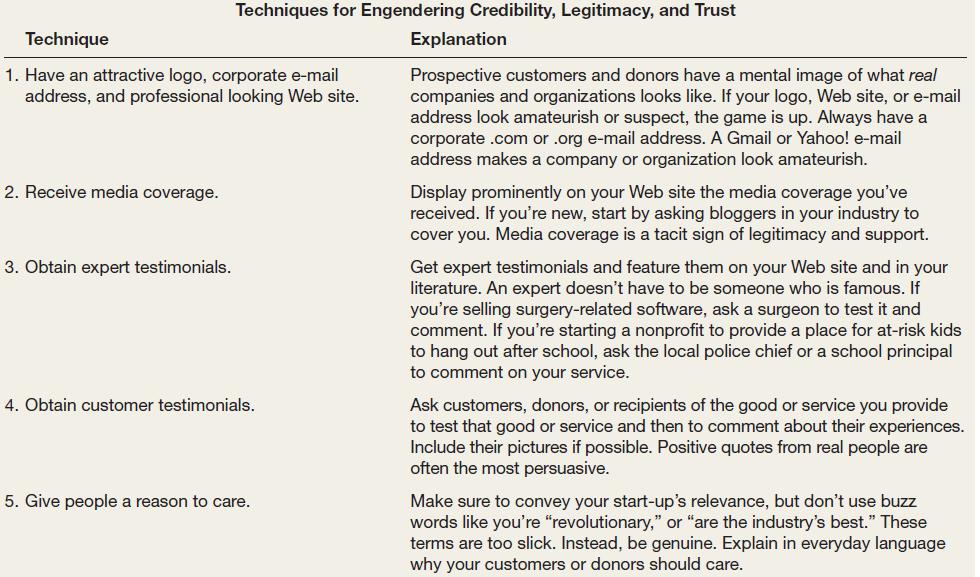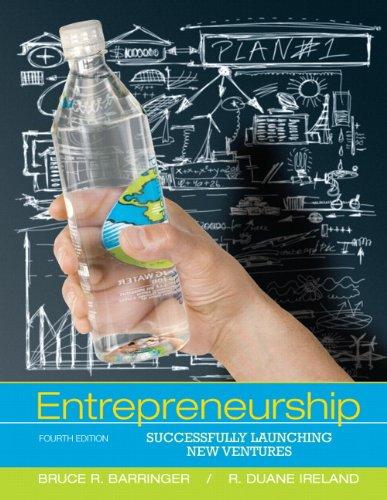Credibility is a vital part of any start-ups persona. Whether a prospective customer in a for-profit context,
Question:
Credibility is a vital part of any start-up’s persona. Whether a prospective customer in a for-profit context, or a prospective donor in a nonprofit context, it’s important that the company or organization presents itself in a manner that builds credibility and trust during first encounters. Both consumers and donors have multiple options for allocating their money. As a result, it’s essential that a start-up make a favorable first impression and give its patrons reasons to trust it.
How Companies and Organizations Build Credibility and Trust
There are several ways companies and organizations can build credibility and trust. We present eight techniques that are essential in nearly all cases in the following list.
The following are examples of how two organizations—one for-profit and one nonprofit—are building credibility and trust via these techniques.
SmartyPants
Launched in 2010, SmartyPants sells children’s vitamins via the Internet. While there are many companies that sell children’s vitamins, SmartyPants is unique in that it’s the only company solely dedicated to children’s vitamins. It’s also an advocate for “brain health.” The scientific link between healthy brains, healthy bodies, cognitive development, and emotional well-being is well-documented. All children benefit from appropriate daily supplements of three micronutrients that support brain health—Omega 3, DHA, and Vitamin D. Until now, these micronutrients could be bought separately, but were not available in a single tablet. SmartyPants Gummy Multi-Vitamins include each of these micronutrients, plus 11 others.
That’s the product. Here’s how SmartyPants is building credibility and trust via the eight techniques described previously.
1. It has a professional logo design, beautiful Web site, and corporate e-mail address.
2. It’s attracted considerable press. Its founders have been interviewed on MSNBC. It’s been featured by Daily Candy, ModernMom, ecomom, ecofabulous, and in various other media outlets.
3. It’s pediatrician approved. According to Dr. Robert Kramer, chairman of the Department of Pediatrics (retired) Baylor University Medical Center, “SmartyPants helps parents ensure their children are getting all the nutrients they need.”
4. Prime real estate on its Web site is devoted to “What Parents Are Saying about SmartyPants Multi-
Vitamins.” Pictures of parents and kids are included.
Samantha S. from New York, New York, for example, says “My girl is a very picky eater and I love that she loves SmartyPants.”
5. The company prominently displays material about the connection between brain health and mental, physical, and emotional well-being. Vitamins are part of the route to achieving brain health.
6. An “Our Story” tab is included on the toolbar at the top of SmartyPants’s Web site. It was started by parents and entrepreneurs who have the same dreams and aspirations that all parents have for their children.
7. The company is active on both Twitter and Facebook. As of April 2011, it had 2,274 Twitter followers and 10,826 Facebook friends.
8. The firm provides a 100 percent money-back guarantee. In addition, it’s partnered with Vitamin Angels, a nonprofit organization, which distributes micronutrients, especially Vitamin A, to infants and children in developing nations. Every time someone buys a SmartyPants bottle of vitamins, the company makes a one-to-one nutrient grant through Vitamin Angels. It says it cares about kids. This proves it.
SmartyPants prominently features this information on its Web site. It’s tastefully done, provides useful information, conveys the company’s values, and provides multiple opportunities (i.e., newsletter, blog, Twitter, Facebook) for prospective customers to get to know the company before trying it out. While these techniques serve multiple purposes, they’re essential in helping SmartyPants build credibility and trust with its target market.

Discussion Questions
1. On a scale of 1 to 10 (10 is high), rate both SmartyPants and DonorsChoose in their efforts to build credibility and trust. Highlight one thing that particularly impresses you about both organizations.
2. Is it appropriate for a company to comment on its ethical standards on its Web site or in its marketing literature? If so, how should a firm or organization approach this task?
3. How can building credibility and trust help a firm or organization avoid legal disputes?
4. What are things that start-ups, whether they are for-profit or nonprofit, do that have the opposite effect of the techniques described in this feature:
they engender a lack of credibility and mistrust?
Application Questions
1. What techniques can a firm or organization use to build credibility and trust that aren’t mentioned in this feature? Provide examples of firms that are using the techniques that you suggest.
2. The “You Be the VC 7.2” feature focuses on Prefense, a company that’s making a hand sanitizer that a person has to apply only once a day. Spend some time studying the company. Based on the information you find, comment on the job that Prefense is doing to build credibility and trust with its target market.
Step by Step Answer:

Entrepreneurship Successfully Launching New Ventures
ISBN: 9780132555524
4th Edition
Authors: Bruce R. Barringer, R. Duane Ireland





